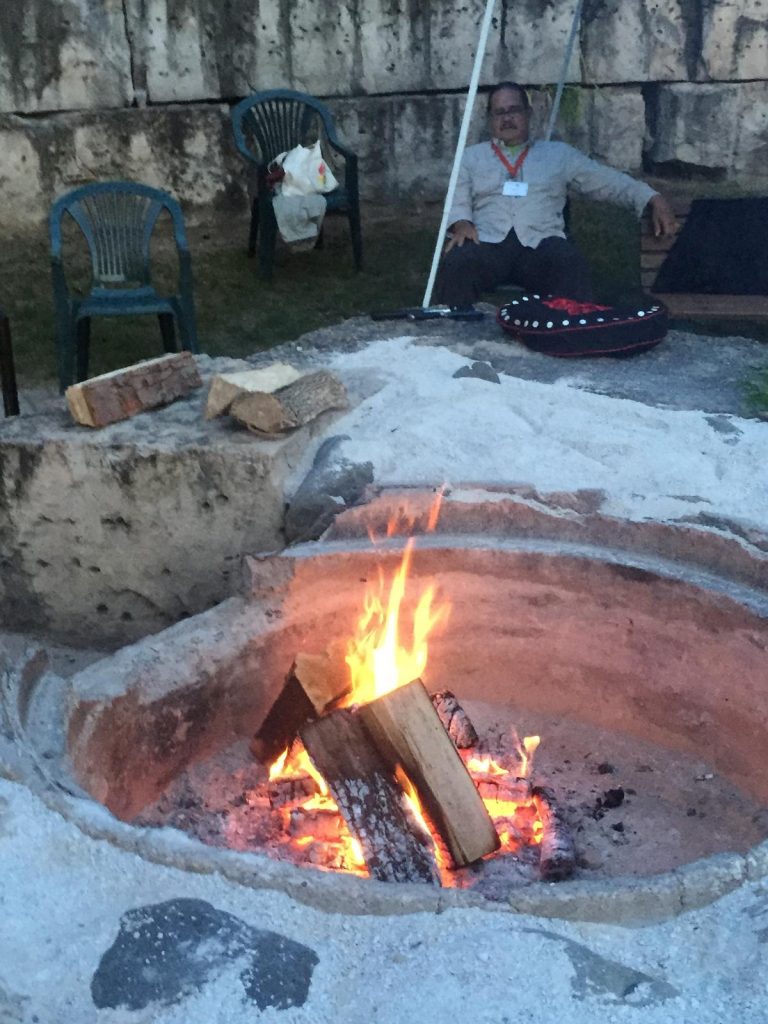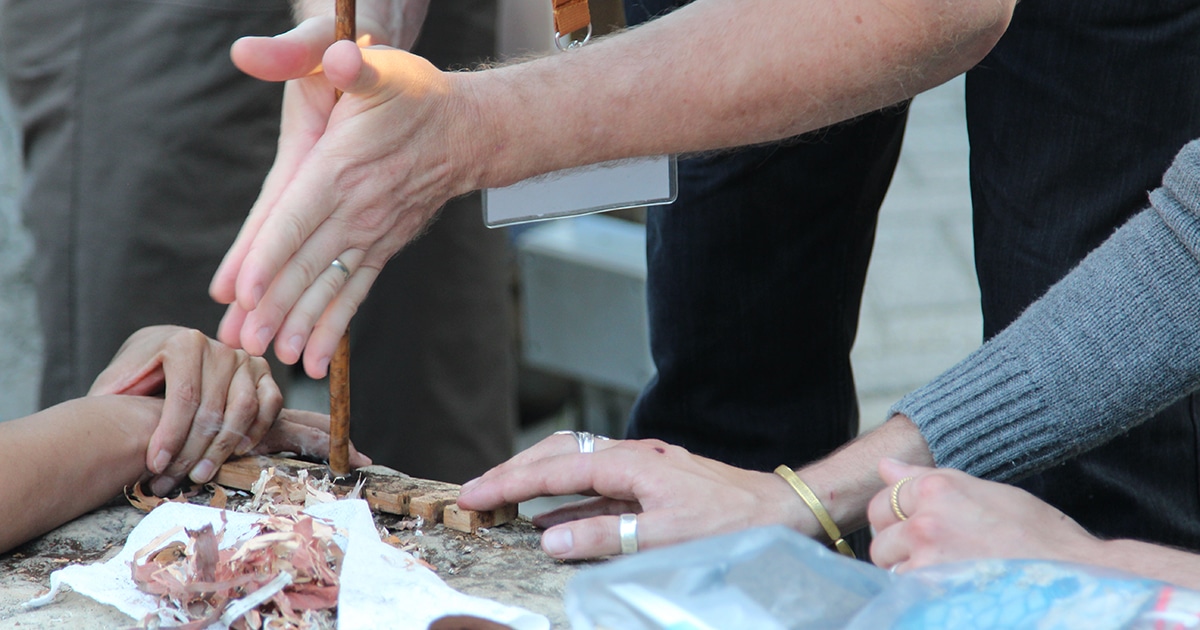Gathered outside in the early morning hours, a circle of onlookers watched as volunteers rubbed spindles into fireboards, trying to produce enough friction to create an ember.
For young men in the Diné tradition, building a fire from scratch remains a rite of passage. The hard work of sparking a blaze without the aid of matches, lighters, etc. teaches virtues such as patience, forbearance, and perseverance.
For those attending the eighth national Anglican Indigenous Sacred Circle in Port Elgin, Ont. from Aug. 16-22, sparking the Sacred Fire that would burn symbolically throughout the week offered a similar learning experience to those who volunteered their efforts.
The lighting of the Sacred Fire marked the ceremonial kick-off of the event. For hours after 6:30 a.m., Indigenous and non-Indigenous Anglican volunteers took turns rubbing the spindles between their hands and holding down the fireboards.
The recurring sight of smoke from the tinder nest led to periodic waves of excitement, before volunteers were brought back to earth when the embers failed to light. Yet the longer they tried to light the fire, the more determined and inventive they became.
As the official fire-keeper at Sacred Circle, Steven Darden, Diné from Navajoland, had knowingly left various items out, and eventually, one enterprising young man seized on the idea of using a block of wood to apply further pressure on top of the spindle.
Six hours after efforts to light it began, volunteers finally managed to light the Sacred Fire in a matter of minutes.
“It was amazing to see the joy of accomplishment,” recalled Darden.
A symbolic flame
The fire began burning occurred just as delegates, bishops, youth, staff, facilitators, counsellors and listeners inside the adjacent UNIFOR Family Education Centre celebrated Holy Communion.

Darden remained outside, as he will for the remainder of the week. Yet his duties as fire-keeper extend far beyond tending to the Sacred Fire, illustrating the extent to which the flame symbolizes many of the goals of Sacred Circle itself.
“I’m in prayer constantly,” Darden noted. “My prayer is simple—the relatives that are gathered [at Sacred Circle], they have issues at home. The communities need hope, communities need space, communities need love; communities need compassion.”
“As the fire-keeper,” he added, “your job is to … form a shield around them as they’re gathered in there, celebrating whatever they’re celebrating, dealing with whatever issues that they’re dealing with in the circles.”
As Sacred Circle delegates grapple with the issues facing Indigenous communities, the Sacred Fire represents the endurance of traditional Indigenous wisdom and teachings.
“Prayer also is to wherever their home fires burn—let that fire never die,” Darden said.
The Primate’s sermon
The first full day of Sacred Circle, however, made it clear that the crises affecting Indigenous people need to be the concerns for all Anglicans and all Canadians.
A sermon by Archbishop Fred Hiltz, Primate of the Anglican Church of Canada, during the opening Eucharist service set the tone. His homily compared the church to the people of Israel from the Old Testament reading in turning away from its evangelical call to follow “other gods” such as imperialism, the institutionalizing of racism and policies of assimilation.
While noting the changing attitudes that led to the 1993 apology for the church’s role in administering Indian residential schools, the Primate painted the Truth and Reconciliation Commission (TRC) as another turning point.
He expressed his hope that the church would turn the TRC’s 94 Calls to Action into priorities for its ministry among and with Indigenous people.
“If we are true to an abiding commitment to an evolving relationship … the church can do no less, for the love of Jesus compels us,” he added.
Many delegates were moved by the Primate’s sermon, noting the urgency needed to confront ongoing challenges in Indigenous communities such as poverty, addiction, and the need to protect traditional cultures and languages.
Statement—Talking circles
After lunch, delegates broke into talking circles to discuss the latest draft of the statement Where We Are Today: Twenty Years after the Covenant, an Indigenous Call to the Wider Church.
Reflecting on the document’s call for Indigenous self-determination within the church, National Indigenous Anglican Bishop Mark MacDonald described how the power of the Holy Spirit had been felt historically among Indigenous people who took hymns, prayers and the Gospels and celebrated them in their own way.
“Today we wish to see that Spirit released among the people and on the land,” Bishop MacDonald said. “Our excitement is to see the things that our elders believed in long ago are coming to fruit.”
In their responses, the small talking groups reacted positively overall to the statement, while calling for more details to be included on the relationship between Indigenous people and the wider church, lingering colonial attitudes and how to address ongoing crises faced by Indigenous communities.
Keynote of the day—Climate change
For the evening presentation, Bishop MacDonald discussed the issue of climate change from a biblical and Indigenous perspective.
Early on, he noted his preference for the term “climate injustice” as the people who stand to suffer the most from the effects of climate change—the poor, the dispossessed, people of the land—are those who had the least to do with creating the problem, as is the case with residents in the Arctic.
While many non-Indigenous people view crimes such as residential schools, the transfer of populations, and dispossession of people from their land as largely consigned to the past, Bishop MacDonald found direct parallels with modern threats against Indigenous people and the land all humans depend on for life, driven by the same forces of money, government and power.
Responding to the question “Where do you find Indigenous people in the Bible?” he offered the stories of Elijah, Elisha and Jeremiah as examples of figures who returned to their Indigenous ways to find peace and truth with God and to call nations back to righteousness.
“To be Indigenous is to be a prophetic witness, and that’s what our people remain today—especially our elders,” he said, describing the fight against climate injustice as a modern example of this prophetic witness.
Interested in keeping up-to-date on news, opinion, events and resources from the Anglican Church of Canada? Sign up for our email alerts .

